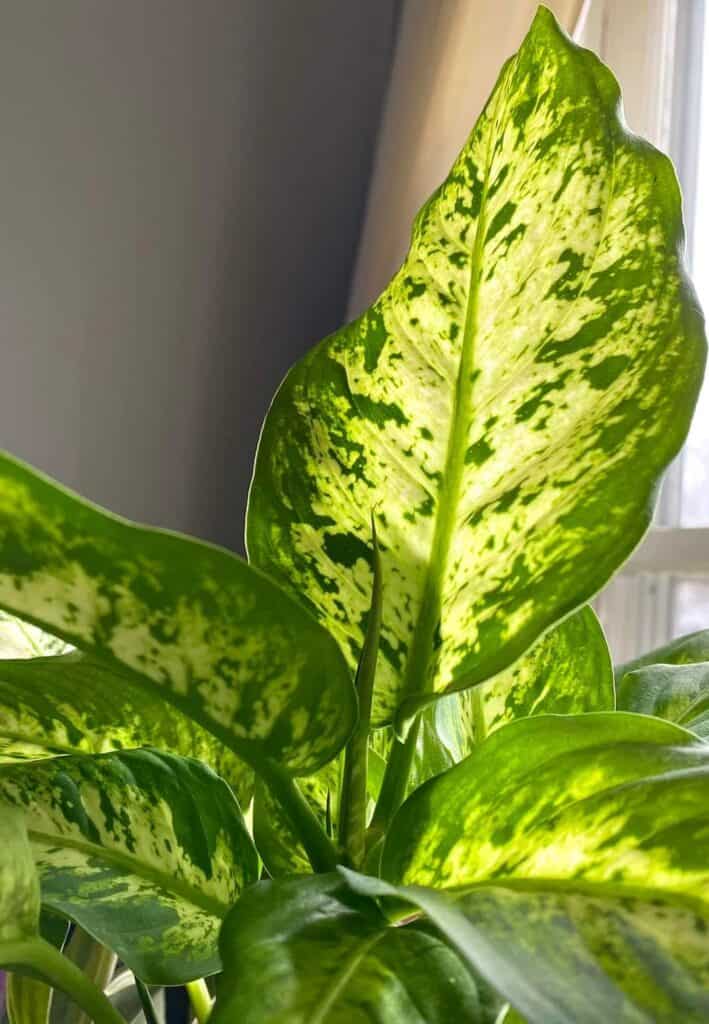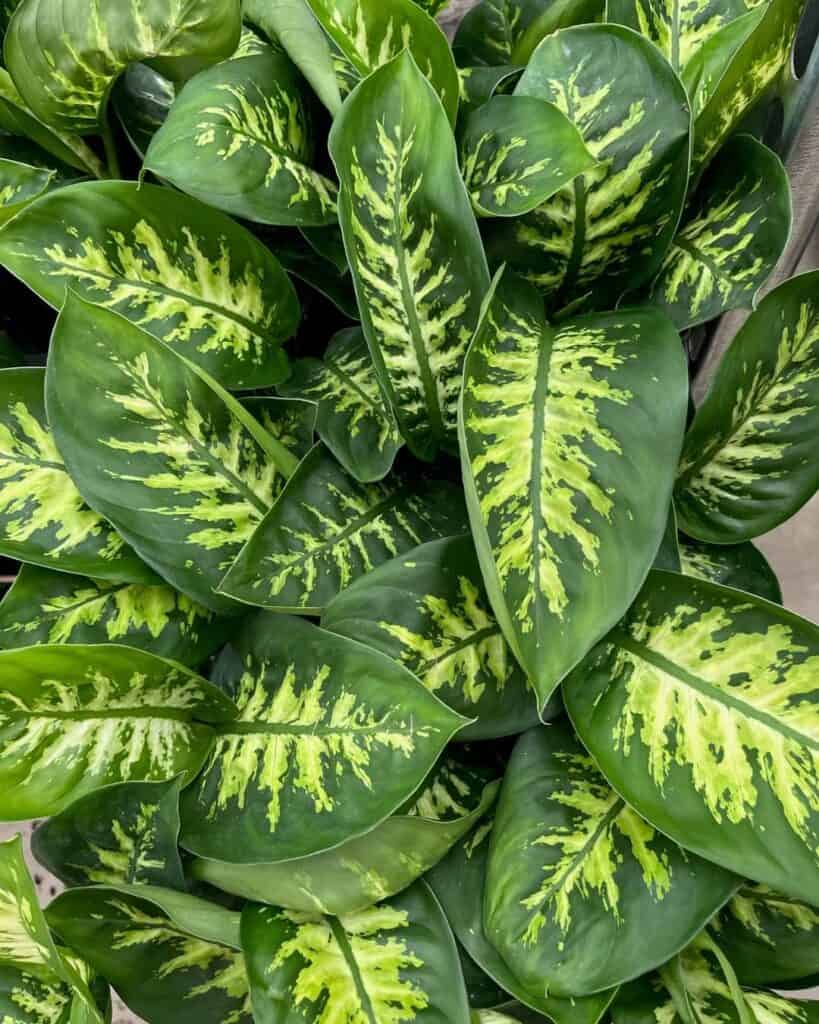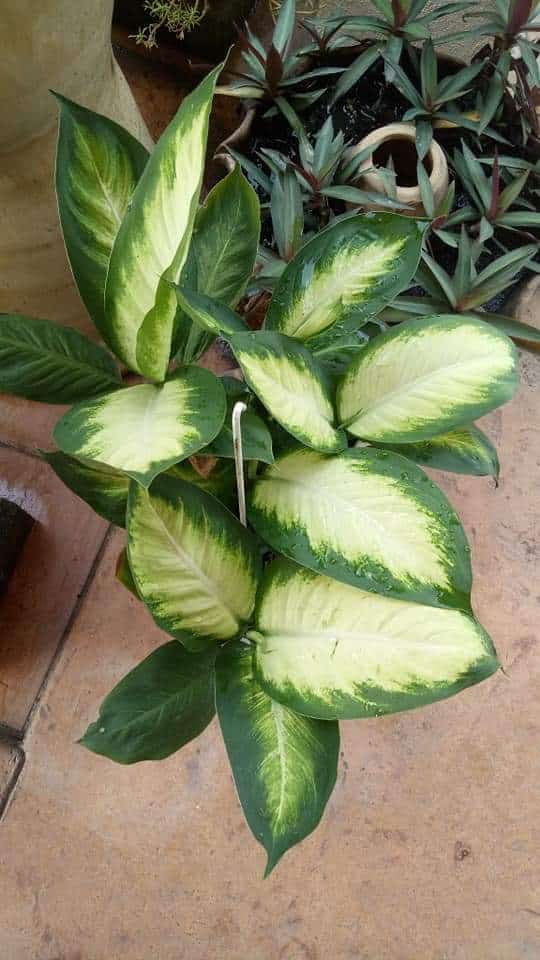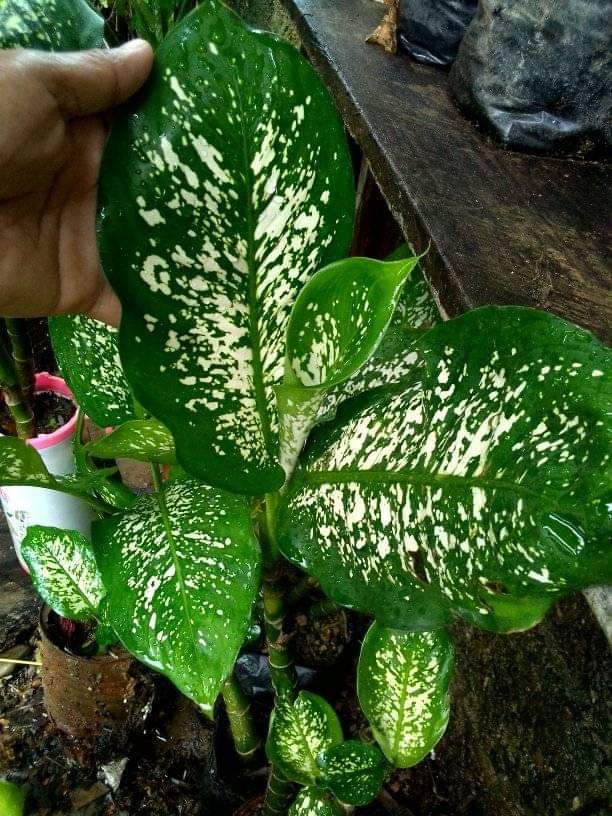Growing beautiful-looking Dieffenbachia plants may be a great idea because these low-maintenance plants will thrive in almost any condition.
Moreover, their large, colorful leaves will effectively cleanse indoor air of toxins, improve air quality, and add to the decor.
In general, Dieffenbachia plants display over 50 species boasting shades of cream, yellow, green, and white, with varying sizes (3 to 6 feet) and unique-looking spadix flowers under ideal conditions.
Dieffenbachia is said to ward off evil spirits and improve your health in Brazilian folklore. However, they will falter when incorrectly watered or lose color without proper lighting.
Read on to find out some of the best Dieffenbachia species and how to care for them effectively.
Table of Contents
- How Many Types of Dieffenbachia are There?
- Why Choose Dieffenbachia Plant?
- 15 Types of Dieffenbachia with Pictures and Names
- 1. Dieffenbachia Honeydew
- 2. Dieffenbachia Maculata ‘Tropical Tiki’
- 3. Dieffenbachia Seguin
- 4. Dieffenbachia Carina
- 5. Dieffenbachia Tropic Snow
- 6. Dieffenbachia Camouflage
- 7. Dieffenbachia Sterling
- 8. Dieffenbachia Panther
- 9. Dieffenbachia ‘Camille’
- 10. Dieffenbachia ‘Compacta’
- 11. Dieffenbachia ‘Delilah’
- 12. Dieffenbachia Tropic Marianne
- 13. Dieffenbachia White Etna
- 14. Dieffenbachia Rebecca ‘Jewel’
- 15. Dieffenbachia Daguensis
- Other Dieffenbachia Varieties
- Tips to Care for Dieffenbachia Plant
- Conclusion
How Many Types of Dieffenbachia are There?
Dieffenbachia (Dieffenbachia Schott), commonly known as Dumb cane or Leopard lily, is a tropical shrub hailing from Central and South America.
Native to new world tropics, they are widely sold as ornamental houseplants and are highly admired for their thick, large, and rich colored leaves.

Did you know Dieffenbachia belongs to the Arum family (Araceae), closely related to the large-leaf-bearing Monstera and Philodendron?
The Amazonian plant was named after Joseph Dieffenbach (1796-1863), a European head gardener at Schönbrunn Palace in Vienna.
It boasts a variety of cultivars with variegated white and green, cream and green, or all-green leaves. Some varieties may even display speckled, splotched, or loosely striped leaves.
Finding a large growing Dieffenbachia variety may be difficult because the tallest Dieffenbachia plant D. Amoena grows only to a height of 6 feet.
However, each variety may boast a straight stem and simple yet alternate leaves with spots and dots, making it attractive as an ornamental plant grown mainly in the empty wall, bedrooms, and dens.
If you are looking for rare cultivars, consider getting Dieffenbachia Rebecca or Daguensis, which are only found through exotic plant sellers.
Many growers tend to confuse Aglaonema as a type of Dieffenbachia.
Although a part of the same Arum family, Aglaonema displays different-looking leaves slightly with silvery patterns while Dieffenbachia boasts white, cream, or yellow pattern.
Moreover, Aglaonema leaves are smaller and more elongated and display diverse patterns, including pink and red.
Why Choose Dieffenbachia Plant?
Dieffenbachia is primarily grown for magnificent-looking foliage but flowers because most varieties rarely flower indoors.
However, the varieties that manage to blossom will boast a lovely-looking flower resembling a peace lily.
It significantly improves indoor air quality by absorbing CO2 and air-borne toxins, including formaldehyde, xylene, and toluene.
It is an easy low-light plant that will display large leaves in colorful shades.
Apart from their ornamental look, some Dieffenbachia varieties possess medicinal benefits, where the plant sap is used to cure warts and tumors.
15 Types of Dieffenbachia with Pictures and Names
Here is the list of the top fifteen varieties to grow around you, if you are in awe of the flourishing Dieffenbachia plant
These are decorative varieties you can display at home or office.
1. Dieffenbachia Honeydew
Dieffenbachia Honeydew is a unique and colorful species hailing from Mexico and is known to be hardy and drought tolerant.
It boasts broad leaves that display lines of different hues of green and white and is easily recognizable for its golden-yellow leaves with a green border.
A mature plant will reach over 3 feet tall and boast leaves measuring around 12 to 16 inches in length and 2 to 3 inches wide.

The thick leaves easily prevent transpiration, making them perfect houseplants for warmer regions such as USDA 10 or above.
It also makes one of the most commonly grown Dieffenbachia plants, as you can find them at reasonable prices in the nearby nurseries.
Consider this Dieffenbachia variety to decorate your living room or office if you fancy a table plant. It does well with moderate watering and a few hours of lighting.
Note: Dieffenbachia Honeydew is not known to produce blossoms.
2. Dieffenbachia Maculata ‘Tropical Tiki’
Dieffenbachia Maculata is a tall growing plant with large decorative leaves, perfect for keeping on empty spaces and walls.
Dieffenbachia Tropical Tiki boasts creamy blotches in the middle of green leaves in both light and dark shades.

Some may even attain yellow with ivory splotches, but this is rare. It makes a fantastic houseplant and prefers bright indirect sunlight, requiring warm temperature and bright areas close to the window.
When matured, the variegated leaves will get 8 inches long with a thick and smooth texture.
It will attain a height of 2 to 3 meters when adequately cared for, but most plants will stay not more than 1.3 meters. However, it is not grown for flowers but decorated leaves.
Do not confuse it with Dieffenbachia Seguine, as the latter boasts lined markings on the leaves instead of blotches.
3. Dieffenbachia Seguin
Dieffenbachia Seguine makes a perfect ornamental houseplant with highly decorative leaves and lined markings.
Native to Southern Mexico, Brazil, and Puerto Rico, it displays cane-like stems and white-cream leaves.
The leaves may grow up to 12-inches and boasts veined line marketing colored in yellow or cream.

When mature, the plant will grow no more than a foot in height, making them a short decorative plant, but they are easy to propagate, making them a perfect beginner’s plant.
When the conditions are ideal, Dieffenbachia Seguin will display showy white flowers that resemble peace lilies.
Note: The white spadix will bear fruit with red or red-orange berries as it matures.
4. Dieffenbachia Carina
Dieffenbachia Carina is one of the most beautiful houseplants, boasting leathery leaves with white and creamy middle and green edges.
It is commonly used for aesthetic effect as it remains short but gives decorative foliage, and it will grow to approximately 15-20 inches and display large, broader leaves.

Native to Mexico and Argentina, this plant stays drought-tolerant and requires less watering.
Dieffenbachia Carina is a good option to grow them both indoors and outdoors.
You can quickly grow them in nurseries and online stores, and they will remain trouble-free with optimal care.
5. Dieffenbachia Tropic Snow
Dieffenbachia Tropic Snow, also known as dumb cane, resembles the tropical tiki plant.
However, it displays large oblong green leaves with variegation ranging from white to gold in the middle.
You can easily spot the Tropic snow by their leaves, measuring 4 to 6 inches long and slightly curled at the end. It will grow 6 to 10 feet tall in the wild, but indoors it will stay at 6 feet.

Also, one of the largest Dieffenbachia varieties, you can consider trimming the spent leaves and leggy stem to limit its growth.
It may look overwhelming initially, but it is one of the easiest houseplants and thrives in low light. However, please keep it away from the cold drafts.
Dieffenbachia Tropic Snow is a beautiful plant to have in your room, with ovate leaves that are mottled with shades of white or yellow.
6. Dieffenbachia Camouflage
Dieffenbachia Camouflage is known for its unique foliage that gives it the impression of a camouflaged plant.
It displays oval-shaped leaves with wavy edges, colored in light and bright shades with deep veined lines. In addition, it shows dark splotches around the leaves.

However, the different cultivar displays different hues of green, where some are dark green.
When properly cared for, it can reach a height of 3.75 feet (45 inches) and boast broader leaves. Ensure ample indirect sunlight to help boost the foliage growth.
Dieffenbachia Camouflage is a slow-growing plant that will hardly produce about 5 to 6 leaves per year.
Gardeners opine placing them at the window to ensure they get adequate indirect sunlight.
Do not forget to complement this beautiful plant with the brightly colored and hand-sculptured container.
7. Dieffenbachia Sterling
Dieffenbachia Sterling is a stunning plant with vibrant colored leaves, often prized as a beautiful decorative plant.
You would love to add them to your houseplant collections because they are easy to care for.
Dieffenbachia Sterling boasts stunning green leaves with bold white midribs from the leaf base to the tip creating a herring-bone pattern.

Most gardeners find it in contrast to other Dieffenbachia varieties because of the unique-looking color that stays vibrant year around.
It will thrive indoors with bright indirect sunlight, so you should avoid growing them outdoors.
However, it is a slow-growing plant that will only grow a few inches every year.
A mature plant will grow about 3 feet in height with a well-branched structure averaging 4 to 8 basal shoots.
8. Dieffenbachia Panther
Dieffenbachia Panther is a striking houseplant known for its large foliage size and attractive foliage design.
It displays thin-oval-shaped leaves with green edges, white splotches, and dotted markings around the leaf.
Some Panther varieties will display either white or cream splotches. When properly cared for, the plant will reach about 3 feet in height and 3 feet wide and showcase highly decorative foliage.

The great thing about them is that you can grow them indoors and outdoors, including nursery beds.
Otherwise, you can transfer them to a container and keep them indoors.
Remember, Dieffenbachia Panther does not grow flowers even when kept outdoors. Instead, it develops showy leaves reaching over 8″ in length and a few inches wide.
9. Dieffenbachia ‘Camille’
Dieffenbachia Camille, also known as Dumb Cane ‘Camille’, is one of the laid-back varieties that grow well in nearly all conditions.
Originating in Central and South American forests, it boasts a lush tropical appearance and habit.
Dieffenbachia Camile displays broad, thin leaves with a lime-colored center and deep green edges fading to white in the center.

Do not be confused when visiting the store; look for a Dieffenbachia with pale yellow leaves and white margins.
Do you know that Dieffenbachia Camile is also known as Leopard Lily Camile?
When cared for, it will grow about 3 feet in height and display large, broad leaves measuring even a foot in length.
As the plant matures, the leaves will become large and oval-shaped.
10. Dieffenbachia ‘Compacta’
Dieffenbachia Compacta is a beautiful variety that resembles Dieffenbachia Camille with its light-colored midrib and deep green edges.
Dieffenbachia Compacta is a beautiful variety that resembles Dieffenbachia Camille with its light-colored midrib and deep green edges.
One way to identify Dieffenbachia Compact is through its big pointy leaves with green edges and creamy midrib with greenish-white patches.

It is a beginner plant that requires minimal care and ample medium sunlight. Remember to provide it with a conducive growing environment to witness a 2 to 3 feet long plant with massive foliage.
They love being outside in the summer but ensure to keep them away from direct sunlight.
However, your Dieffenbachia Compact will fail to grow flowers.
11. Dieffenbachia ‘Delilah’
Dieffenbachia Delilah is a unique variety that boasts big pointy leaves with greenish whitish patches in the center and unusual edges.
Dieffenbachia Delilah is also one of the tallest Dieffenbachia plants, reaching a height of 2 to 3 meters (6.5 to 10 feet).

However, many sellers mark it as the rare Dieffenbachia; hence, you would pay more.
When grown indoors, it may only attain a height of 1.3 meters (4.2 feet); however, you can easily display it in the empty corners and living room.
Dieffenbachia Delilah is easy to care for and hardy, which can withstand drought conditions. You can also grow them outdoors in spring and summer.
It displays large decorative leaves measuring 12 to 14 inches long and 6-8 inches wide, so it may need some space to spread.
12. Dieffenbachia Tropic Marianne
Dieffenbachia Tropic Marianne is a striking dieffenbachia variety to grow at home.
Often claimed to be the show-stopper among Dieffenbachia species, it is widely prized for its broad foliage and creamy texture.
Dieffenbachia Tropic Marianne displays hosta-type, oblong leaves with a creamy texture and deep green border. When matured, the leaves may become up to 12 inches broad.

In an ideal condition, it may reach 6 feet or above. They are best kept in colorful containers around the house or showcased in hanging baskets.
Care to provide ample indirect sunlight as they will falter in poorly lit areas, losing vibrant color and vigor.
Note: Dieffenbachia Tropic Marianne is not known to blossom.
13. Dieffenbachia White Etna
Dieffenbachia Etna is a beautiful variety known for its unique leaves, which boast an unequal amount of colorful splotches and markings.
It displays evenly green broad leaves marked with tiny, white splotches that will stand out whether grown indoors or outdoors.

The Dieffenbachia White Etna will achieve a height of 35 inches or about 3 feet when provided with excellent care.
However, do not confuse it with Dumbcane ‘Reflector’, which also boasts similar-looking leaves with white blotches.
Due to the rarity in supply, you will only find them through exotic plant sellers.
14. Dieffenbachia Rebecca ‘Jewel’
Dieffenbachia Rebecca, also known as Rebecca Jewel, is one of the most popular yet rare varieties of Dieffenbachia plants.
It displays broad leaves with bold variegation that often mesmerizes the onlookers but fails to maintain the same variegation when overlooked.

The broad Dieffenbachia Rebecca leaf measures over a foot and half a foot wide and features white variegation.
With changing light, the lower leaf will begin turning yellow; therefore, you should provide ample bright light to maintain the coloration.
This Dieffenbachia Rebecca Jewel is not known to produce flowers but is quite handy regarding low maintenance. Remember to provide ample indirect sunlight and keep them close to bright windows.
15. Dieffenbachia Daguensis
Dieffenbachia Daguensis is a unique-looking variety that displays large, broad leaves with deep green coloration and light splotch in the middle.
A fantastic feature about this plant is that the only side will display splotches, often coming in a different color.

Hailing from Colombian forests, they are best grown indoors and enjoy dappled sunlight to maintain bright foliage.
However, please keep it away from drafts as it may damage the foliage appearance. When properly cared for, it will grow to 3 feet and display bushier foliage growth.
Other Dieffenbachia Varieties
Here are a few Dieffenbachia varieties you should keep on your bucket list.
| Varieties | Features | Image |
|---|---|---|
| Dieffenbachia Star Bright | 1. It displays leathery foliage 2. The broad leaves are colored in green and yellow variegation |  |
| Dieffenbachia Aurora | 1. It displays dark green foliage 2. The leaf has uneven patch of lime yellow |  |
| Dieffenbachia ‘Triumph’ | 1. It displays large, broad leaf 2. The leaf is marked with green edges and yellow midrib |  |
| Dieffenbachia Amoena | 1. It displays leathery, waxy leaves 2. Resembles D. Triumph with green border and yellow midrib |  |
| Dieffenbachia ‘Tropic Rain’ | 1. It boasts light green leaves 2. The green leaves are marked by tiny spots and freckles with white hues 3. It maintains a short stature |  |
| Dieffenbachia ‘Sparkle’ | 1. It shows off light green leaves 2. The leaves are blotched with dark green and white patches 3. It grows about 3-4 feet |  |
| Dieffenbachia ‘Sarah’ | 1. It makes excellent indoor plant 2. It displays variegated leaves with green edges and cream patches |  |
Tips to Care for Dieffenbachia Plant
Dieffenbachia is an easy-to-care tropical houseplant that grows well both indoors and outdoors.
Depending on the variety, it can grow well in high, low, or medium light, adding drama and flair to the decor.
However, it requires a conducive environment to maintain its richly variegated foliage.
Here are a few proven tips for caring for your Dieffenbachia plant.
- Grow Dieffenbachia in USDA zone 10 to 12 with a warm environment to thrive and maintain rich vegetation.
- Provide a temperature between 70 to 80°F in the growing season and nothing less than 50°F.
- Ensure the soil remains well-drained and porous. Use a potting soil rich in peat moss and perlite with soil acidity of 6.1 to 6.5 pH.
- Keep watering to moderate to ensure the pot remains medium moist. Water once per week or every two weeks, depending on the variety.
- Avoid overwatering and overhead watering to prevent fungal and bacterial infestation.
- They are best grown in dappled sunlight with medium to high light and are best kept in east or south-facing window.
- Apply a liquid houseplant fertilizer with 20-20-20 NPK at half strength every six weeks to two months in the growing season.
- In winter, better place them inside under the appropriate LED grow light or when the temperature drops below 50°F.
- Provide 60 percent humidity level throughout the year.
- Not all Dieffenbachia species will blossom; hence, refrain from supplying flower boosters.
Conclusion
Dieffenbachia makes a perfect ornamental plant around the house, office, and garden. Remember to ask the seller whether your preferred Dieffenbachia can grow indoors or outdoors.
They can grow well in any environment, but ensure it does not get cold as they are not cold-hardy.
Use this guide to choose your favorite Dieffenbachia plant, and keep the growing tips in mind.
Happy Plant Parenting!
